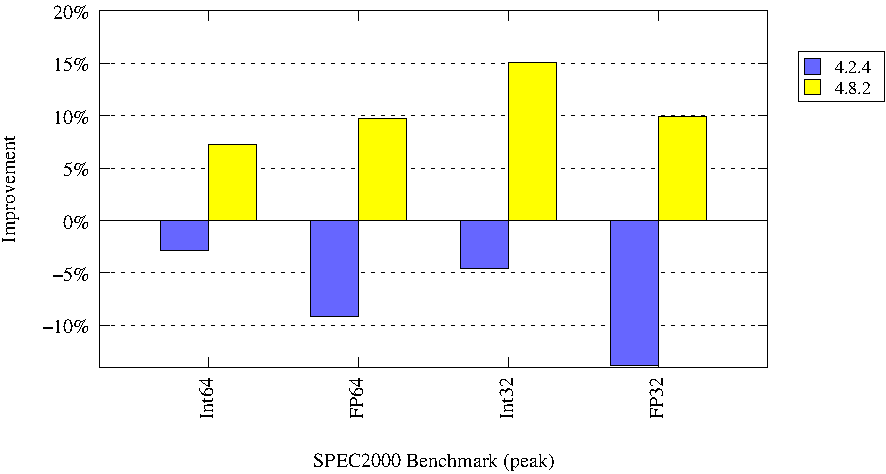The importance of using a fresh version of GCC.
Usually comparing performance of different versions of GCC I use the
same set of options. Such comparison shows how the existing GCC
optimizations were improved or how general optimization sets (-O2 or
-O3) were improved.
But GCC development adds new features, new processor supports which
are not switched on by the general optimization sets. Here I am
comparing peak performance (or more accurately saying close to peak performance)
which can be achieved on modern processors by different versions of
GCC.
For this comparison I use Intel Haswell processor (3.4 GHz
i5-4670) and GCC-4.2.4, GCC-4.4.4, and GCC-4.8.2.
Why do I use these versions of GCC? It is pretty obvious for GCC-4.8
as it is the latest release of GCC. GCC-4.2 is chosen because it is
the last version of the compiler with GPL v2 used by Apple in
OS X (although latest Mavericks OS just imitates gcc command by LLVM,
it is still true for older OS X versions). GCC-4.4 is chosen as it is
a system compiler of some latest commercial LINUX distributions,
e.g. RHEL-6.
I used the following options:
- -Ofast -flto -march=core-avx2 -mtune=core-avx2
for GCC-4.8.2 generating 64-bit code, and the same option set
plus
-mfpmath=sse -m32 -mpc64 for 32-bit code.
- -O3 -ffast-math -mtune=core2 -march=core2 for GCC-4.4.4
for 64-bit and the same set plus -mfpmath=sse -m32
-mpc64 for 32-bit.
- -O3 -ffast-math -mtune=nocona -march=nocona for GCC-4.2.4
for 64-bit code and the same set plus -mfpmath=sse
-m32 for 32-bit code.
Here are some important remarks about the used
options. -Ofast and LTO were not implemented
in GCC-4.4 and GCC-4.2 yet. The same is about AVX2 support.
The closest implemented machine architecture option can be used to
tune code for Haswell are nocona and core2 for GCC-4.2 and GCC-4.4
correspondingly. As -Ofast switches
on -ffast-math, the later option was added for GCC-4.4
and GCC-4.2.
Here are the SPEC2000 performance rates for the comparison (changes
in percents relative to GCC-4.4 are given in parentheses):
| 64-bit | 4.2 | 4.4 | 4.8 |
| Int | 3832 (-2.9%) | 3945 (0%) | 4228 (+7.2%) |
| FP | 5001 (-9.2%) | 5508 (0%) | 6040 (+9.7%) |
y
| 32-bit | 4.2 | 4.4 | 4.8 |
| Int | 3468 (-4.6%) | 3636 (0%) | 4184 (+15.1%) |
| FP | 4251 (-13.8%) | 4933 (0%) | 5420 (+9.9%) |
Or in graphic form the performance changes relative to GCC-4.4.4
look:

If somebody is interesting in code size, here are average changes of
size of SPEC benchmarks code (text segment) generated by GCC-4.2 and GCC-4.8
relative to size of code generated by GCC-4.4:
| 64-bit | 4.2 | 4.8 |
| Int | -10.1% | -5.6% |
| FP | -28.2% | -10.4% |
| 32-bit | 4.2 | 4.8 |
| Int | -8.8% | -3.1% |
| FP | -26.2% | +2.2% |
GCC is too big to follow all its development. But in my opinion
such improvements since GCC-4.2 were achieved mostly by:
- LTO (+IPA and inlining improvements).
- developments in RA which can deal with bigger functions with
higher pressure (as the result of lto and more aggressive
inlining). It is seen well on 32-bit Int benchmarks when we have
only 7 int regs.
- new vector insns support. Unfortunately, graphite optimizations
give nothing so I did not use it for 4.8.2.
Last modified: 03/18/2014 - vmakarov at redhat dot com
Return to index page.
